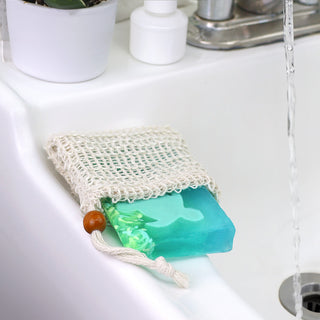Melt-and-pour soap making is one of the easiest and most enjoyable ways to explore the world of handcrafted skincare. This method enables you to create beautiful, customized soaps without the complexity and safety concerns associated with cold or hot process soap making. You only need a pre-made soap base, some additives such as colorants and fragrance oils, and a bit of creativity.
When starting a melt-and-pour project, one of the first choices you'll face is deciding between clear and white soap bases. While both types serve as the foundation for your soap, they differ in appearance, ingredients, and how they interact with colorants, embeds, and designs.
At first glance, the distinction might seem purely visual, but the choice between a transparent and white base can significantly affect the outcome of your soap. Understanding the differences will help you achieve your desired aesthetic and improve the quality and performance of your finished bars.
Let us discuss the unique characteristics of clear and white melt-and-pour bases, compare their pros, and help you decide which one best suits your project.
What Is a Melt-and-Pour Soap Base?
A melt-and-pour soap base is a pre-made block of soap that can be melted down, customized, and poured into molds to create finished soap bars. This method is popular because it requires minimal equipment and eliminates the need for lye handling, making it a safe and beginner-friendly option.
You can find different types of bases designed for various needs—fragrance-free, oatmeal, shea butter, aloe vera, and more. Clear and white are the two foundational options that set the tone for your soap's appearance and design capabilities.
Clear Melt and Pour Soap Base
Features
The clear base is translucent and is often referred to as "glycerin soap" due to its high glycerin content. When melted and poured, it retains a glass-like clarity, making it ideal for visual effects.
Pros
1. Transparency for Design: The clear base's most significant advantage is its see-through quality. It is ideal for embedding decorative items, such as dried flowers, toy figurines, loofah slices, or layered color patterns.
2. Bright Colors: Clear bases allow vibrant and bold colors to shine through. A clear base is the way to go if you want a vivid blue, green, or red soap.
3. Professional Finish: The glossy look gives soaps a polished, boutique-style appearance.
Best For
1. Artistic or decorative soap designs
2. Layered or embedded soap projects
3. Soaps are meant for visual appeal.
White Melt and Pour Soap Base
Features
The base of white soap is opaque due to the addition of a white pigment that gives the soap a creamy look. It has the same base ingredients as clear soap but with a different visual outcome.
Pros
1. Classic Aesthetic: The white base gives a clean, creamy, and luxurious appearance that many associate with traditional soap.
2. Easy to Work With: The opacity makes it more forgiving for beginners, especially when coloring or scenting.
3. Color Control: Although the colors appear more pastel or muted, the white base provides a uniform canvas for predictable results.
Best For
1. Rustic, natural-looking bars
2. Swirled designs and simple colors
3. Soaps with herbal or spa-like aesthetics
Comparison Table
|
Feature |
Clear Base |
White Base |
|
Appearance |
Transparent/Translucent |
Opaque/Creamy White |
|
Ideal Use |
Embedding & Layering Designs |
Solid Colors & Swirls |
|
Color Intensity |
Bright & Vivid |
Soft & Muted |
|
Moisture Attraction |
Higher |
Lower |
|
Beginner Friendly |
Moderate |
Very Friendly |
|
Artistic Potential |
High (for visual designs) |
Medium (better for simplicity) |
|
Popular Look |
Boutique-style |
Traditional |
Choosing the Right Base for Your Project
So, how do you choose between clear and white melt-and-pour soap bases? It all depends on your creative vision and the purpose of your soap.
Ask yourself:
1. Do I want to embed something?
Go with clear soap base.
2. Do I want bold, vibrant colors?
A clear base will help colors pop more.
3. Do I prefer a clean, minimalist look?
Choose white soap base for a creamy, elegant finish.
4. Is this my first time making soap?
White bases are more forgiving and easier to handle for beginners.
You don't need to stick to just one base, either. Many soap makers use both, depending on the project. For example, you might use a white base for a lavender-scented spa bar and a clear base for a colorful, kid-friendly layered soap.
Pro Tips for Working with Both
Whether you're using transparent or white melt-and-pour bases, the following tips will help you get professional results:
Preventing Glycerin Dew
1. Wrap finished soaps tightly in plastic wrap.
2. Store in a cool, dry place.
Coloring Tips
1. Add color slowly and stir thoroughly to avoid streaks or cloudiness in clear bases.
2. Test colors on a small batch before committing to a larger quantity.
Layering and Swirling
1. When layering clear and white bases together, let each layer cool slightly before pouring the next to avoid bleeding.
2. To create swirls in a white base, pour at different temperatures and use a skewer or chopstick to swirl gently.
Scenting
1. Use skin-safe essential oils or fragrance oils that are safe for your skin.
2. Add scents after melting and just before pouring to preserve fragrance strength.
Conclusion
Clear and white melt-and-pour soap bases may share the same core function, but their differences play a significant role in how your final soap will look and feel. Clear bases are best for artistic expression and embedded designs, while white bases offer a soft, classic appearance that's easy to work with and perfect for everyday use.
The best base is the one that fits your creative goals. Experimenting with both types is the best way to develop your style and discover what works for you.
At Primal Elements, we offer premium-quality melt-and-pour soap bases at competitive prices. Call us now! - (800) 434-8277


